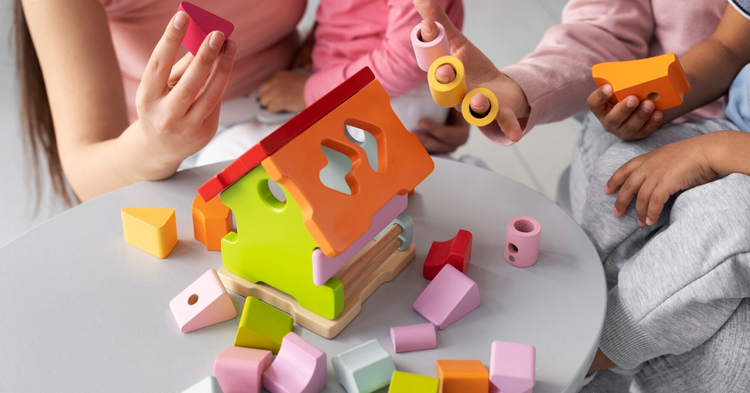Play-based learning fosters children's innate curiosity while imparting critical communication and problem-solving skills. Consider the negotiation and planning required to establish and oversee a makeshift café or construct a block castle. The value of play is undeniable, and many early childhood programs adopt a play-based approach. However, the definition of "play" and its full range of benefits are still being worked out.
What is play?
In the research on play-based learning, there are two types of play that have been studied, free play and guided play:
| Free Play | Guided Play |
|---|---|
| Definition | Definition |
| Free play refers to unstructured, child-directed play where children have the freedom to choose their activities, set their rules, and follow their interests without external guidance or specific learning objectives imposed by adults. | Guided play maintains elements of child autonomy and choice while incorporating adult guidance or scaffolding to direct children toward specific learning goals or objectives. |
| Characteristics | Characteristics |
| - Child-Led: Children take the lead, directing their play without adult intervention. | - Structured Yet Flexible: Adults provide some structure or guidance while allowing children to explore and discover. |
| - Spontaneous: It occurs naturally and spontaneously, driven by children's curiosity and imagination. | - Learning Objectives: It's designed to achieve specific educational outcomes while retaining elements of child-directedness. |
| - Imagination and Creativity: Encourages exploration, imaginative scenarios, and unrestricted creativity. | - Adult Involvement: Educators or adults may offer prompts, questions, or resources to support learning without dictating the play. |
| - Autonomy and Decision-Making: Children make decisions, solve problems, and negotiate with peers independently. | - Balancing Play and Learning: Balances playfulness with intentional learning opportunities. |
| Benefits | Benefits |
| - Self-Regulation: Helps children learn to manage emotions, solve problems, and make decisions independently. | - Enhanced Learning Outcomes: Offers learning experiences tailored to specific educational goals or concepts. |
| - Creativity and Innovation: Fosters imaginative thinking, creativity, and divergent problem-solving skills. | - Adult Support: Provides scaffolding and support for children's learning while maintaining their autonomy. |
| - Social Skills: Enhances social interaction, cooperation, and communication among peers. | - Cognitive Development: Helps in problem-solving, critical thinking, and skill development within a playful context. |
OK, so what is play-based learning?
Play-based learning is, essentially, learning while playing and through play. It recognizes and leverages the natural inclination of children to explore, experiment, and make sense of the world through play activities. This method integrates structured play experiences within educational settings to foster various aspects of a child's development, including cognitive, social, emotional, and physical domains.
What does play-based learning teach children?
The short answer: everything.
Play builds important social-emotional, self-regulation, developmental, and academic skills.
Play-based learning offers a rich and diverse array of lessons and skills that contribute to children's holistic development across various domains:
Cognitive Development:
Problem-Solving Skills: Through play, children encounter challenges and puzzles that require them to think critically and devise solutions, honing their problem-solving abilities.
Imagination and Creativity: Play encourages the exploration of diverse scenarios, fostering imaginative thinking and creativity.
Math and Literacy Concepts: Play-based activities often incorporate elements that introduce mathematical concepts like counting, sorting, and shapes, as well as literacy through storytelling, reading, and writing in a context that feels natural and enjoyable.
Social and Emotional Skills:
Communication and Collaboration: Interacting with peers during play helps children develop communication skills, learn to express themselves, and negotiate with others.
Empathy and Emotional Regulation: Role-playing and imaginative scenarios in play allow children to explore emotions, understand perspectives, and learn to regulate their emotions.
Conflict Resolution: Play-based settings provide opportunities for children to encounter conflicts and learn how to resolve them through negotiation and compromise.
Physical Development:
Gross and Fine Motor Skills: Various types of play, such as outdoor activities, construction play, or arts and crafts, support the development of motor skills and coordination.
Spatial Awareness: Building with blocks, navigating play structures, and engaging in pretend play all contribute to a child's spatial understanding and awareness.
Executive Functioning:
Self-Regulation and Focus: Play activities require children to manage their impulses, wait their turn, and stay focused on tasks, enhancing their self-regulation skills.
Planning and Organization: Creating play scenarios, building structures, or engaging in complex games necessitates planning and organization, fostering these skills.
Creativity and Innovation:
Divergent Thinking: Play encourages children to explore multiple possibilities, think outside the box, and approach problems from different angles.
Innovation and Experimentation: Children engage in trial-and-error processes during play, fostering a mindset that values experimentation and learning through exploration.
Play-based learning is an immersive experience where children absorb knowledge, skills, and attitudes in a holistic and integrated manner.
It provides a foundation for lifelong learning, fostering curiosity, resilience, and adaptability crucial for success in the later stages of life.
The “what” kids learn from play-based learning is extensive. They learn cognitive, physical, emotional, social, and creative skills.
- When kids play, they learn to share, cooperate, communicate, and solve problems.
- Play helps children express emotions in a helpful and healthy way.
- Play builds children’s sense of empathy and relationship building.
- Play builds language skills as children engage with one another and gain vocabulary.
- Imaginative play helps children think outside the box and develop perspective-taking.
- Play builds fine and gross motor skills and coordination, as kids crawl, walk, run, jump, and work with smaller objects during play.
What do teachers do in play-based learning?
In a play-based classroom, teachers play a crucial role in creating a supportive and enriching environment that encourages children's exploration, learning, and development through play. Their responsibilities involve various key aspects:
Setting the Environment:
Designing the Space: Teachers arrange the classroom to stimulate curiosity and invite exploration, with different play areas offering diverse experiences such as imaginative play, sensory activities, building, reading, and more.
Selecting Materials: They choose toys, tools, and resources that support open-ended play, allowing for creativity and flexibility in how children use them.
Observing and Guiding:
Observation: Teachers observe children's play closely, noting their interests, interactions, and developmental progress to inform their teaching strategies.
Facilitating Play: They intervene minimally, allowing children to lead while subtly guiding and extending their play by asking open-ended questions or providing additional materials or challenges.
Scaffolding Learning: Teachers offer support, scaffolding children's learning by providing hints, suggestions, or additional information to deepen understanding or overcome challenges.
Planning and Assessment:
Curriculum Design: Teachers develop a flexible curriculum that integrates play-based activities aligned with educational goals and developmental milestones.
Assessment: They assess children's progress through informal observations and documentation, understanding their strengths, interests, and areas needing support.
Building Relationships:
Supporting Social Interactions: Teachers foster a positive and inclusive environment, encouraging cooperation, sharing, and empathy among children.
Connecting with Families: They communicate with parents, sharing insights into children's progress, offering suggestions for activities at home, and collaborating to support children's learning.
Modeling and Encouraging:
Demonstrating Playfulness: Teachers engage in play themselves, modeling creativity, curiosity, and enjoyment in learning.
Encouraging Curiosity: They spark curiosity by asking open-ended questions, encouraging exploration, and celebrating children's discoveries and efforts.
Flexibility and Adaptation:
Adapting to Children's Needs: Teachers remain flexible, adjusting activities and approaches based on individual or group interests, needs, or developmental levels.
Watch a teacher guide student-centered play-based learning:
So, teacher involvement in some play is necessary to build academic skills, while free play builds general developmental skills.









